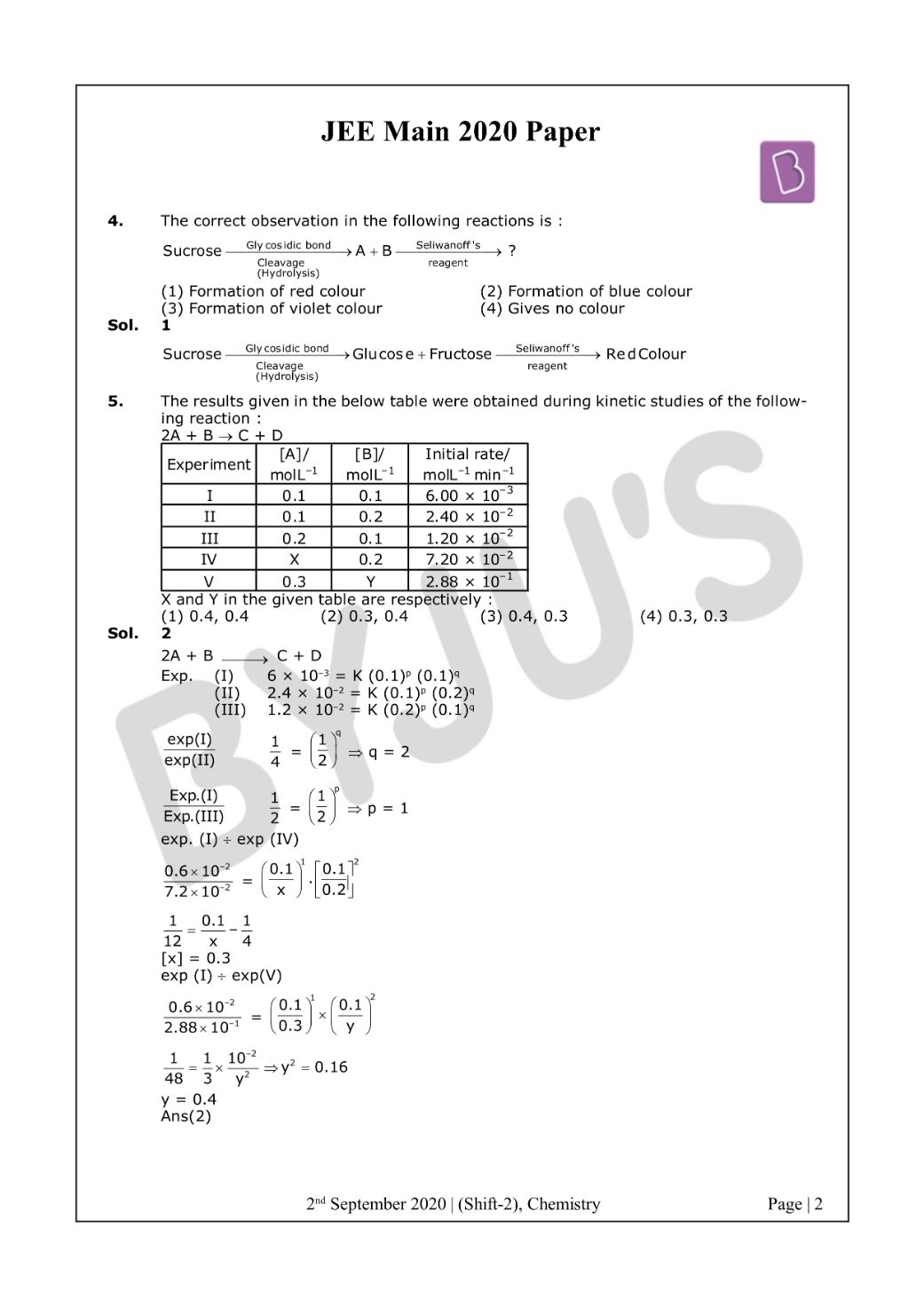1) Wrought iron and steel
2) Wrought iron and pig iron
3) Wrougth iron, pig iron and steel
4) Pig iron, scrap iron and steel
Refer topic metallurgy
Solution: (1)
1) Pentagonal planar and trigonal bipyramidal
2) Trigonal bipyramidal and trigonal bipyramidal
3) Octahedral and square pyramidal
4) Trigonal bipyramidal and pentagonal planar
[XeF5]– 5BP + 2LP = 7VSEP ⇒ sp3d3 hybridisation
XeO3 F2 5BP + 0LP = 5VSEP ⇒ sp3d hybridisation
Solution: (1)

(i) [M(NCS)6](–6+n)
(ii) [MF6](–6+n)
(iii) [M(NH3)6]n+
1) A-(i), B-(ii), C-(iii)
2) A-(iii), B-(i), C-(ii)
3) A-(ii), B-(iii), C-(i)
4) A-(ii), B-(i), C-(iii)
Δ = hc / λabsorbed f(max)
A → NH3 comp (iii)
B → NCS comp (i)
C → F– comp (ii)
Using spectrochemical series of ligand,
F– < NCS– < NH3 order of Δ+e
Crystal field splitting energy
So, NH3 complex → A
F– complex – C
NCS– complex B
Solution: (2)

1) Formation of red colour
2) Formation of blue colour
3) Formation of violet colour
4) Gives no colour

Solution: (1)
|
Experiment |
[A] / mol L-1 |
[B] / mol L-1 |
Initial rate/ molL–1 min–1 |
|
I |
0.1 |
0.1 |
6.00 × 10–3 |
|
II |
0.1 |
0.2 |
2.40 × 10–2 |
|
III |
0.2 |
0.1 |
1.20 × 10–2 |
|
IV |
X |
0.2 |
7.20 × 10–2 |
|
V |
0.3 |
Y |
2.88 × 10–1 |
X and Y in the given table are respectively :
1) 0.4, 0.4
2) 0.3, 0.4
3) 0.4, 0.3
4) 0.3, 0.3
2A + B → C + D
Exp. (I) 6 × 10–3 = K (0.1)p (0.1)q
(II) 2.4 × 10–2 = K (0.1)p (0.2)q
(III) 1.2 × 10–2 = K (0.2)p (0.1)q
exp(I) / exp(II) = 1 / 4 = (1 / 2)q ⇒ q = 2
Exp.(I) / Exp.(III) = 1 / 2 = (1 / 2)p ⇒ p = 1
exp. (I) ÷ exp (IV)
[0.6 × 10-2] / [7.2 × 10-2] = [0.1 / x]1 . [0.1 / 0.2]2(1 / 12) = (0.1 / x) – (1 / 4)
[x] = 0.3exp (I) ÷ exp(V)
[0.6 × 10-2] / [2.88 × 10-1] = [0.1 / 0.3]1 . [0.1 / y]2(1 / 48) = (1 / 3) × (10-2 / y2) ⇒ y2 = 0.16
y = 0.4
Solution: (2)
|
A |
B |
|
(I) ion-ion |
(a) 1 / r |
|
(II) dipole-dipole |
(b) 1 / r2 |
|
(III) London dispersion |
(c) 1 / r3 |
|
(d) 1 / r6 |
1) (I)-(a), (II)-(b), (III)-(d)
2) (I)-(a), (II)-(b), (III)-(c)
3) (I)-(b), (II)-(d), (III)-(c)
4) (I)-(a), (II)-(c), (III)-(d)
ion – ion α (1 / r)
dipole – dipole α (1 / r3)
London dispersion α (1 / r6)
Solution: (4)


Solution: (1)

Which of the following statements is true:
1) Changing the concentration of the base will have no effect on reaction (1)
2) Doubling the concentration of base will double the rate of both the reactions.
3) Changing the base from OH𝚯 to 𝚯OR will have no effect on reaction (2)
4) Changing the concentration of the base will have no effect on reaction (2)

Solution: (1)
1) Diffusion
2) Osmosis
3) Reverse osmosis
4) Dialysis
Theoretical
Osmosis, option (2) is the answer.
Solution: (2)
1) Aqueous NH3
2) Aqueous NaHCO3
3) Aqueous NaOH
4) Vinegar
Fact
Solution: (2)

1) b > a > c > d
2) b > c > d > a
3) c > b > d > a
4) c > b > a > d
Order of acidic strength

Solution: (2)


Solution: (1)
1) Na and Ca
2) Cs and Ba
3) Na and Rb
4) Li and Mg
LiHCO3 & Mg(HCO3)2 does not exist in solid form but both forms nitrides with nitrogen gas.
Solution: 4
1) 4
2) 8
3) 2
4) 16
n = 4
l = 0 m = 0
l = 1 m = – 1, 0, +1
l = 2 m = – 2, + 2, –1, +1, 0
l = 3 m = ± 3, ± 2, ± 1, 0
Answer: ‘2’ Subshells
Solution: (3)


Solution: (3)
|
Test |
C |
D |
|
Ceric ammonium nitrate Test |
Positive |
Positive |
|
Lucas Test |
Turbidity obtained after five minutes |
Turbidity obtained immediately |
|
Iodoform Test |
Positive |
Negative |
C and D respectively are:


Solution: (2)
1) X < Y < Z
2) Y < X < Z
3) Z < Y < X
4) X < Z < Y
x < y < z
Mg Al Si
[Basic oxide] [amphoteric] [acidic oxide]Solution: (1)
1) [Ni(NH3)4 (H2O)2]2+
2) [Ni(en)3]2+
3) [Pt(NH3)2Cl2]
4) [Ni(NH3)2Cl2]
[Ni(NH3)2Cl2] Ni2+ is sp3 hybridised & such tetrahedral complexes do not show either geometric or optical isomerism. [Ni(en)3]2+ shows only optical isomers while the other three shows geometrical isomerism.
Solution: (4)
Question 19: Amongst the following statements regarding adsorption, those that are valid are:
(a) ΔH becomes less negative as adsorption proceeds.
(b) On a given adsorbent, ammonia is adsorbed more than nitrogen gas.
(c) On adsorption, the residual force acting along the surface of the adsorbent increases.
(d) With an increase in temperature, the equilibrium concentration of adsorbate increases.
1) (b) and (c)
2) (c) and (d)
3) (a) and (b)
4) (d) and (a)
Statement ‘a’ & ‘b’
Solution: (3)
1) Pyramidal
2) Trigonal bipyramidal
3) Tetrahedral
4) Square planar
SF4 is Sp3d hybridised in which hybrid orbitals have TBP arrangement but its shape is sea-saw.
Solution: (2)
Solution: The mass ratio of C:H is 4:1 ⇒ 12:3
& C:O is 3:4 ⇒ 12:16
So, mass mole mole ratio
C 12 1 1
H 3 3 3
O 16 1 1
Empirical formula ⇒ CH3O as the compound is saturated a cyclic so, the molecular formula is C2H6O2.

So, required moles of O2 is ⇒ 5
Given:

2Cu+ ⇌ Cu(s) + Cu2+
Eº = 0.52 – 0.16
= 0.36
Eº = [RT / nF] ln (keq)
ln (keq) = [0.36 / 0.025] (1 / 1)
= 360 / 25 = 14.4
= 144 × 10–1
The answer is 144.
ɸ = 4.41 × 10–19 J
λ = 300 nm
KEmax = [hc / λ] – ɸ
= [6.63 x 10-34 x 3 x 108] / [300 x 10-9] – 4.41× 10–19
= 6.63 × 10–19 – 4.41 × 10–19
= 222 × 10–21
The answer is 222.

Solution: 19
ΔHco [C2H5OH] = –327 kcal
C2H5OH(l) + 3O2 (g) → 2CO2 (g) + 3(H2O)(l)
ΔEco = ΔHco – ΔngRT
= – 327 × 1000 – (–1) × 2 × 300
= – 327000 + 600
= – 326400
Video Lessons – September 2 Shift 2 Chemistry





JEE Main 2020 Chemistry Paper January 9 Shift 2









Comments